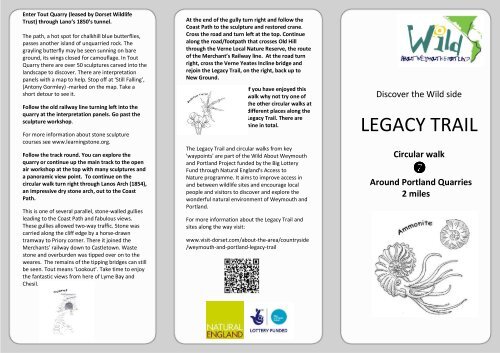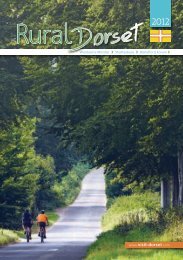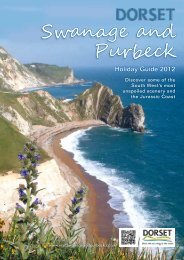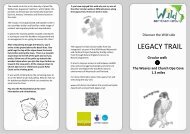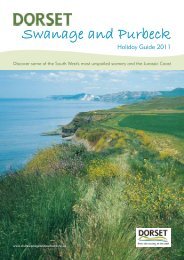LEGACY TRAIL - Visit Dorset
LEGACY TRAIL - Visit Dorset
LEGACY TRAIL - Visit Dorset
You also want an ePaper? Increase the reach of your titles
YUMPU automatically turns print PDFs into web optimized ePapers that Google loves.
Enter Tout Quarry (leased by <strong>Dorset</strong> Wildlife<br />
Trust) through Lano’s 1850’s tunnel.<br />
The path, a hot spot for chalkhill blue butterflies,<br />
passes another island of unquarried rock. The<br />
grayling butterfly may be seen sunning on bare<br />
ground, its wings closed for camouflage. In Tout<br />
Quarry there are over 50 sculptures carved into the<br />
landscape to discover. There are interpretation<br />
panels with a map to help. Stop off at ‘Still Falling’,<br />
(Antony Gormley) -marked on the map. Take a<br />
short detour to see it.<br />
Follow the old railway line turning left into the<br />
quarry at the interpretation panels. Go past the<br />
sculpture workshop.<br />
For more information about stone sculpture<br />
courses see www.learningstone.org.<br />
Follow the track round. You can explore the<br />
quarry or continue up the main track to the open<br />
air workshop at the top with many sculptures and<br />
a panoramic view point. To continue on the<br />
circular walk turn right through Lanos Arch (1854),<br />
an impressive dry stone arch, out to the Coast<br />
Path.<br />
This is one of several parallel, stone-walled gullies<br />
leading to the Coast Path and fabulous views.<br />
These gullies allowed two-way traffic. Stone was<br />
carried along the cliff edge by a horse-drawn<br />
tramway to Priory corner. There it joined the<br />
Merchants’ railway down to Castletown. Waste<br />
stone and overburden was tipped over on to the<br />
weares. The remains of the tipping bridges can still<br />
be seen. Tout means ‘Lookout’. Take time to enjoy<br />
the fantastic views from here of Lyme Bay and<br />
Chesil.<br />
At the end of the gully turn right and follow the<br />
Coast Path to the sculpture and restored crane.<br />
Cross the road and turn left at the top. Continue<br />
along the road/footpath that crosses Old Hill<br />
through the Verne Local Nature Reserve, the route<br />
of the Merchant’s Railway line. At the road turn<br />
right, cross the Verne Yeates Incline bridge and<br />
rejoin the Legacy Trail, on the right, back up to<br />
New Ground.<br />
.<br />
If you have enjoyed this<br />
walk why not try one of<br />
the other circular walks at<br />
different places along the<br />
Legacy Trail. There are<br />
nine in total.<br />
The Legacy Trail and circular walks from key<br />
'waypoints' are part of the Wild About Weymouth<br />
and Portland Project funded by the Big Lottery<br />
Fund through Natural England's Access to<br />
Nature programme. It aims to improve access in<br />
and between wildlife sites and encourage local<br />
people and visitors to discover and explore the<br />
wonderful natural environment of Weymouth and<br />
Portland.<br />
For more information about the Legacy Trail and<br />
sites along the way visit:<br />
www.visit-dorset.com/about-the-area/countryside<br />
/weymouth-and-portland-legacy-trail<br />
Discover the Wild side<br />
<strong>LEGACY</strong> <strong>TRAIL</strong><br />
Circular walk<br />
<br />
Around Portland Quarries<br />
2 miles
Start<br />
Below, the Portland limestone (150 million years) was<br />
created in a shallow, tropical sea where giant<br />
ammonites swam. The top layer, ‘Roach Stone’, is full<br />
of fossils, moulds and casts of marine molluscs;<br />
bivalves known as ‘osses eads’, looking like horse<br />
heads, and turreted coiled snails called ‘Portland<br />
screws’. King Barrow has lots of them. Below, Base<br />
and Whit Beds, formed in deeper waters are the<br />
easily-cut and sculptured limestone, famous across<br />
the world and removed in large quantities from King<br />
Barrow Quarries.<br />
Still falling is carved on the island of<br />
unquarried rock to your left. Follow<br />
the path around to the back face.<br />
Follow the Legacy Trail from New Ground Car Park<br />
into King Barrow Quarries, a <strong>Dorset</strong> Wildlife Trust<br />
Reserve, last quarried over 100 years ago.<br />
Look out for clues of past quarrying. There are<br />
‘beaches’ of quarry waste behind huge, dry stone<br />
walls stacked by quarrymen and old horse -drawn<br />
tramway routes used by wagons to transport stone.<br />
In spring and summer, the quarries are ablaze with<br />
colour with wildflowers like pink wild thyme,<br />
pyramidal Orchids, yellow lady’s bedstraw and<br />
vetches and vipers bugloss with its vivid blue flower<br />
spikes.<br />
Length of walk: c 2 miles<br />
Access: Free parking at New<br />
Ground Car Park. Nearest bus<br />
stop is at the Heights Hotel. It<br />
is a steep, uneven path into<br />
quarry but the remaining<br />
route is gently undulating<br />
with a largely natural and at<br />
times rocky path surface. A<br />
Tramper mobility scooter is<br />
available for use on some of<br />
this walk from the Heights<br />
Hotel.<br />
As the path narrows, the Legacy Trail turns right to<br />
go through the quarrymen’s tunnel.<br />
Take time to look straight ahead to the outcrop of<br />
unquarried rock. Take care there are steep drops. The<br />
top beds of Lower Purbeck (145 million years old)<br />
were formed in shallow, water lagoons surrounding<br />
low, forested islands; a thick layer of hard cap can be<br />
seen above a fossil soil. On the ledge is a fossil tree<br />
bole. Algae grew around the bases of trees, building<br />
up the doughnut shapes. Holes in rock around the<br />
quarry are not drill holes but cavities left by ancient<br />
tree branches. Dinosaurs roamed at this time too.<br />
We know because they have left there footprints on<br />
Portland!<br />
Turn right to follow the Legacy Trail into ‘Jurassic<br />
Gully’ (left goes to the Verne Local Nature Reserve<br />
via an old horse drawn tramway route).<br />
This is a quiet, sheltered gully with hart’s-tongue fern<br />
and the unusual ivy broomrape, a parasite of Ivy.<br />
Look out for a quarrymen’s shelter in the retaining<br />
wall. Leave the shade and come out onto shorter<br />
grassland with abundant wildflowers and a good<br />
butterfly spot. Look out for marbled white in longer<br />
grass and delicate blue butterflies on shorter turf and<br />
open rocky areas, including chalkhill, small and<br />
common blue and Portland’s special silver-studded<br />
blue. In late summer, the migrant clouded yellow<br />
butterfly may be seen.<br />
Keep straight ahead until you see another footpath<br />
track coming in from the right. Turn right here<br />
leaving the Legacy Trail which goes to the left.<br />
Alternatively, you could go straight to see Admiralty,<br />
a modern quarry with a spectacular section through<br />
the rock strata, before returning to the route.<br />
The non-native and highly invasive cotoneaster shrub<br />
is being removed. The ‘beaches’ are used by slow<br />
worms, common lizards and for nesting, by little owls.<br />
Follow the track straight on and out of the quarry,<br />
via a shady path to Easton Road. Turn right and<br />
then cross the road to follow the footpath sign into<br />
Inmosthay Quarry. This is an old horse drawn<br />
tramway route.


